Example mudbrick seal

The brick stamping mold for Sin-Iddinam of Larsa is housed in the Louvre. It is a nearly complete mold, with an inscription in cuneiform to the Sun God, Utu, as a foundation deposit for the god's temple, the Ebbabar.
The mudbrick stamp or brick seal of Mesopotamia are impression or stamp seals made upon bricks or mudbrick. The inscribed seal is in mirror reverse on the 'mold', mostly with cuneiform inscriptions, and the foundation mudbricks are often part of the memorializing of temples, or other structures, as part of a "foundation deposit", a common honoring or invocation to a specific god or protector.

The brick stamping mold for Sin-Iddinam of Larsa is housed in the Louvre. It is a nearly complete mold, with an inscription in cuneiform to the Sun God, Utu, as a foundation deposit for the god's temple, the Ebbabar.
Ur was an important Sumerian city-state in ancient Mesopotamia, located at the site of modern Tell el-Muqayyar in south Iraq's Dhi Qar Governorate. Although Ur was once a coastal city near the mouth of the Euphrates on the Persian Gulf, the coastline has shifted and the city is now well inland, on the south bank of the Euphrates, 16 km (10 mi) from Nasiriyah in modern-day Iraq. The city dates from the Ubaid period c. 3800 BC, and is recorded in written history as a city-state from the 26th century BC, its first recorded king being King Tuttues.
Eridu was a Sumerian city located at Tell Abu Shahrain, also Abu Shahrein or Tell Abu Shahrayn, an archaeological site in southern Mesopotamia. It is located in Dhi Qar Governorate, Iraq near the modern city of Basra. Eridu is traditionally believed to be the earliest city in southern Mesopotamia based on the Sumerian King List. Located 12 kilometers southwest of the ancient site of Ur, Eridu was the southernmost of a conglomeration of Sumerian cities that grew around temples, almost in sight of one another. The city gods of Eridu were Enki and his consort Damkina. Enki, later known as Ea, was considered to have founded the city. His temple was called E-Abzu, as Enki was believed to live in Abzu, an aquifer from which all life was believed to stem. According to Sumerian temple hymns another name for the temple of Ea/Enki was called Esira (Esirra).
"... The temple is constructed with gold and lapis lazuli, Its foundation on the nether-sea (apsu) is filled in. By the river of Sippar (Euphrates) it stands. O Apsu pure place of propriety, Esira, may thy king stand within thee. ..."

Sumer is the earliest known civilization, located in the historical region of southern Mesopotamia, emerging during the Chalcolithic and early Bronze Ages between the sixth and fifth millennium BC. Like nearby Elam, it is one of the cradles of civilization, along with Egypt, the Indus Valley, the Erligang culture of the Yellow River valley, Caral-Supe, and Mesoamerica. Living along the valleys of the Tigris and Euphrates rivers, Sumerian farmers grew an abundance of grain and other crops, a surplus which enabled them to form urban settlements. The world's earliest known texts come from the Sumerian cities of Uruk and Jemdet Nasr, and date to between c. 3350 – c. 2500 BC, following a period of proto-writing c. 4000 – c. 2500 BC.
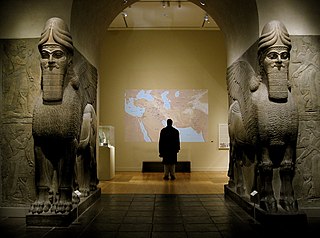
The architecture of Mesopotamia is ancient architecture of the region of the Tigris–Euphrates river system, encompassing several distinct cultures and spanning a period from the 10th millennium BC to the 6th century BC. Among the Mesopotamian architectural accomplishments are the development of urban planning, the courtyard house, and ziggurats. Scribes had the role of architects in drafting and managing construction for the government, nobility, or royalty.

Nippur was an ancient Sumerian city. It was the special seat of the worship of the Sumerian god Enlil, the "Lord Wind", ruler of the cosmos, subject to An alone. Nippur was located in modern Nuffar 5 miles north of modern Afak, Al-Qādisiyyah Governorate, Iraq. It is roughly 200 kilometers south of modern Baghdad and about 96.56 km southeast of the ancient city of Babylon. Occupation at the site extended back to the Ubaid period, the Uruk period, and the Jemdet Nasr period. The origin of the ancient name is unknown but different proposals have been made.

The Kassites were people of the ancient Near East, who controlled Babylonia after the fall of the Old Babylonian Empire c. 1531 BC and until c. 1155 BC.
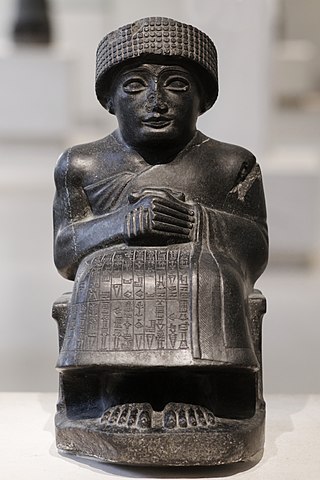
Gudea (Sumerian: 𒅗𒌤𒀀, Gu3-de2-a) was a ruler (ensi) of the state of Lagash in Southern Mesopotamia, who ruled c. 2080–2060 BC (short chronology) or 2144–2124 BC (middle chronology). He probably did not come from the city, but had married Ninalla, daughter of the ruler Ur-Baba (2164–2144 BC) of Lagash, thus gaining entrance to the royal house of Lagash. He was succeeded by his son Ur-Ningirsu. Gudea ruled at a time when the center of Sumer was ruled by the Gutian dynasty, and when Ishtup-Ilum ruled to the north in Mari. Under Gudea, Lagash had a golden age, and seemed to enjoy a high level of independence from the Gutians.

Shar-Kali-Sharri reigned c. 2217–2193 BC as the ruler of the Akkadian Empire. In the early days of cuneiform scholarship the name was transcribed as "Shar-Gani-sharri". In the 1870s, Assyriologists thought Shar-Kali-Sharri was identical with the Sargon of Akkad, first ruler of the Akkadian Empire, but this identification was recognized as mistaken in the 1910s. His name was sometimes written with the leading Dingir sign demarking deification and sometimes without it. Clearly at some point he was deified and two of his designations marked his divine status, "heroic god of Akkade", and "god of the land of Warium". He was the son and successor of Naram-Sin who deified himself during his lifetime.

Nekhen, also known as Hierakonpolis was the religious and political capital of Upper Egypt at the end of prehistoric Egypt and probably also during the Early Dynastic Period.

Adab or Udab was an ancient Sumerian city between Girsu and Nippur. It was located at the site of modern Bismaya or Bismya in the Wasit Province of Iraq. The city-god of Adab was Parag'ellilegarra (Panigingarra) "The Sovereign Appointed by Ellil".
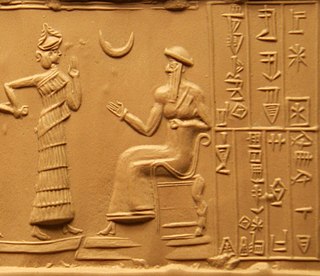
Ur-Nammu founded the Sumerian Third Dynasty of Ur, in southern Mesopotamia, following several centuries of Akkadian and Gutian rule. His main achievement was state-building, and Ur-Nammu is chiefly remembered today for his legal code, the Code of Ur-Nammu, the oldest known surviving example in the world. He held the titles of "King of Ur, and King of Sumer and Akkad".

Seleucia, also known as Seleucia-on-Tigris or Seleucia on the Tigris or Seleucia ad Tigrim, was a major Mesopotamian city, located on the west bank of the Tigris River within the present-day Baghdad Governorate in Iraq. It was founded around 305 BC by Seleucus I Nicator as the first capital of the Seleucid Empire, and remained an important center of trade and Hellenistic culture after the imperial capital relocated to Antioch. The city continued to flourish under Parthian rule beginning in 141 BC; ancient texts claim that it reached a population of 600,000. Seleucia was destroyed in 165 AD by Roman general Avidius Cassius and gradually faded into obscurity in the subsequent centuries. The site was rediscovered in the 1920s by archaeologists.
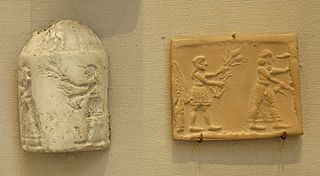
A cylinder seal is a small round cylinder, typically about one inch in length, engraved with written characters or figurative scenes or both, used in ancient times to roll an impression onto a two-dimensional surface, generally wet clay. According to some sources, cylinder seals were invented around 3500 BC in the Near East, at the contemporary sites of Uruk in southern Mesopotamia and slightly later at Susa in south-western Iran during the Proto-Elamite period, and they follow the development of stamp seals in the Halaf culture or slightly earlier. They are linked to the invention of the latter's cuneiform writing on clay tablets. Other sources, however, date the earliest cylinder seals to a much earlier time, to the Late Neolithic period in Syria, hundreds of years before the invention of writing.
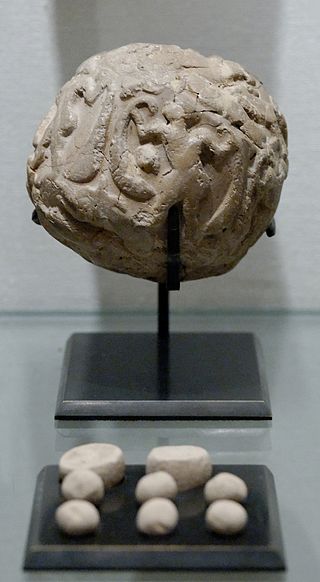
A bulla is an inscribed clay or soft metal or bitumen or wax token used in commercial and legal documentation as a form of authentication and for tamper-proofing whatever is attached to it.
The Dynasty of Isin refers to the final ruling dynasty listed on the Sumerian King List (SKL). The list of the Kings Isin with the length of their reigns, also appears on a cuneiform document listing the kings of Ur and Isin, the List of Reigns of Kings of Ur and Isin.
Kulla, inscribed in cuneiform as dSIG4, where SIG4 was the Sumerogram for Akkadian word libittu, “brick,” was the Sumero-Babylonian brick-god who was invoked alongside Mušdam, the divine architect at the outset when laying a foundation for a building, but consequently banished when construction work was completed in elaborate incantation rituals which formed a part of the exorcist's curriculum. He was formed from a piece of clay that Ea had pinched off in the primeval ocean, in a tale recited as part of the ritual for restoring a temple, “when Anu created heaven.”

The art of Mesopotamia has survived in the record from early hunter-gatherer societies on to the Bronze Age cultures of the Sumerian, Akkadian, Babylonian and Assyrian empires. These empires were later replaced in the Iron Age by the Neo-Assyrian and Neo-Babylonian empires. Widely considered to be the cradle of civilization, Mesopotamia brought significant cultural developments, including the oldest examples of writing.

The Hurrian foundation pegs, also known as the Urkish lions, are twin copper foundation pegs each in the shape of a lion that probably came from the ancient city of Urkesh in Syria. The pegs were placed at the foundation of the temple of Nergal in the city of Urkesh as mentioned in the cuneiform inscriptions on them. The inscription on the two pegs and the associated stone tablet is the oldest known text in the Hurrian language. One of the lions is now housed, along with its limestone tablet, in the Musée du Louvre in Paris. The second lion is on display at the Metropolitan Museum of Art in New York.
Malgium is an ancient Mesopotamian city tentatively identified as Tell Yassir which thrived especially in the Middle Bronze Age, ca. 2000 BC - 1600 BC. Malgium formed a small city-state in an area where the edges of the territories controlled by Larsa, Babylon and Elam converged. Inscribed in cuneiform as ma-al-gi-imKI, its chief deities were Ea and Damkina. A temple of Ulmašītum is known to have been there. There was also a temple to the goddess Bēlet-ilī called Ekitusgestu as well as a temple to the god Anum.

Foundation figures were ritualistic works of art from the Early Dynastic period that were used in the construction of ancient Mesopotamian temples. Foundation pegs first appeared in ancient Sumer around the third millennium BCE. Stylized as anthropomorphic nails, foundation figures were symbolically used to mark the grounds of a temple. These nails/pegs were either hammered around the foundation of the temple, along with an inscribed tablet, or they were buried in clay boxes under the foundation of the temple. Typically, the pegs were created to represent either the deity that the temple was honoring, or the king that orchestrated the construction of the temple. Many of the pegs discovered stand about a foot tall and show a clear attention to detail. It is believed that foundation figures were used for solely ritualistic purposes. This is because they were not meant to be seen by the public, yet still show a high level of detail and aesthetic thought.